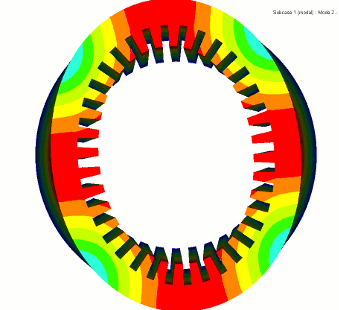Noise and vibrations of electrical machines include electromagnetically-excited sources, aerodynamic sources and mechanical sources. This article briefly explains the origin of magnetic noise and vibrations in electric machines, also called e-NVH in automotive applications.
What is magnetic noise in electric machines ?
Electromagnetic noise and vibrations come from the vibrations of the electric machine active parts in the audible range (20 Hz to 20 kHz) under the excitation of electromagnetic forces, namely magnetostriction and Maxwell forces. A low-speed, high-torque, direct-drive permanent magnet synchronous generator for wind turbine applications may be responsible for a “low frequency” 100 Hz humming noise, while a high-speed brushless DC motor used for instance in model making might create a high-pitch, “high frequency” whining noise up to 8000 Hz.
The role of magnetostriction in noise generation can be generally neglected: based on EOMYS consulting experience on more than 200 electrical machines, it is not the root cause of electromagnetic noise and vibrations in rotating machines.
Maxwell stress is the formalization of how Maxwell forces arise from electromagnetic fields: it includes well-known attraction/repulsion forces between two magnets, and Laplace forces which apply on current conductors in an external magnetic field.
The Maxwell stress tangential net effect on the rotor gives the average electromagnetic torque of the electrical machine, but its tangential and radial harmonics can produce parasitic vibration and acoustic noise.
Resonance effects
When the shape of magnetic forces along the airgap (called a wavenumber) match with a structural mode of the stator and travel at the right speed, vibrations and acoustic noise are amplified significantly: this is the resonance effect.
Resonance occurs when the electrical frequency (not the mechanical frequency) of the travelling force wave of wavenumber r match with the circumferential mode (r,0) natural frequency.
As an example, the following animation shows the modal shape (2,0) of a stator lamination stack:

A rotating radial force of wavenumber r=2 is illustrated here:

Resonance occurs when the electrical frequency of this rotating force wave equals the natural frequency of the mode (2,0).
The modal participation factor of magnetic forces to rotor and stator structural modes can be more rigourously quantified using the concept of Modal Force Matrix (projection of magnetic force on structural modes).
Magnetic noise and vibration reduction techniques
A special article discusses electromagnetic NVH mitigation techniques at design stage of electric machines. This article deals with techniques such as
- topology, pole / slot / phase numbers
- winding
- skewing
- pole magnetization, pole shaping, pole layout, pole width and position
- slot and tooth shape / position
- stator slot opening
- notching
- airgap increase
- control parameters (e.g. current angle, PID)
- harmonic current injection
- switching strategies (e.g. SVPWM, DPWM )
- structural response (e.g. lamination to frame coupling, damping)
- control of geometrical & magnetic asymmetries
EOMYS can help you identifying the root cause of magnetic noise and vibrations, designing and implementing appropriate noise control actions at all design stage of rotating machines.
Magnetic noise and vibration experimental characterization
To know if an electrical machine is noisy because of electromagnetic noise and not because of aerodynamic or mechanical noise, some simple experiments can be carried.
In induction machines for instance, electromagnetic noise stops when the machine is current-free (null stator current). For permanent magnet synchronous machines, cancelling the currents does not cancel all sources of magnetic fields ; it is therefore necessary to drive the machine with demagnetized magnets, or carry more detailed spectral analysis to check if the frequency of the acoustic noise match with the theoretical content of harmonic magnetic forces.
EOMYS has developped some specialized experimental test methodologies to quickly characterize and troubleshoot e-NVH issues in rotating machines (e.g. spatiogram post-processing). The combination of Manate simulation software and advanced e-NVH tests allows EOMYS to efficiently identify e-NVH sources and transfer paths, and propose a noise mitigation plan.